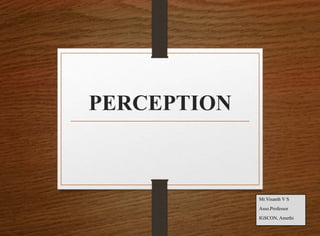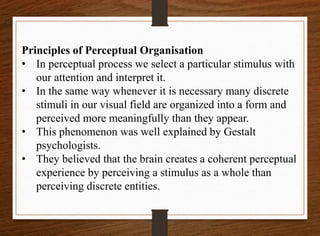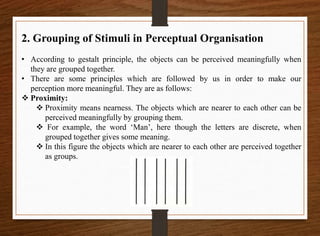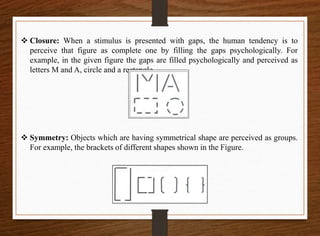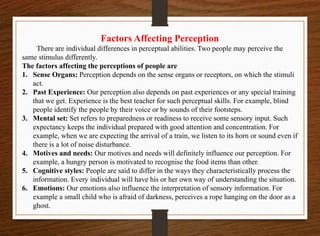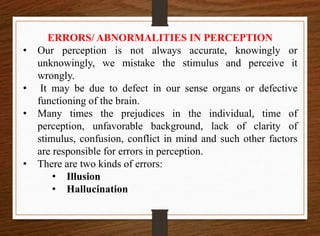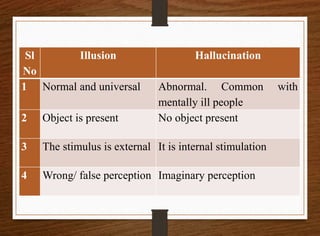- 1. PERCEPTION
Mr.Visanth V S
Asso.Professor
IGSCON, Amethi
- 2. Perception
• Everyday different stimuli around us will be stimulating our sense
organs. Many of these stimuli are received by our sense organs and
are converted into sensations.
• These sensations are transmitted to the concerned parts of brain.
Hence in understanding the world around us, attention occurs first,
followed by sensation and finally interpretation by brain.
• This process of ‘interpretation of stimulus is known as perception’.
• So perception involves two processes: sensation and interpretation.
- 3. Definition
• Perception may be defined as a process of interpretation of
a present stimulus on the basis of past experience.
• All the processes involved in creating meaningful patterns
out of a jumble of sensory impressions fall under the
general category of perception—Charles Jorris
• Perception is the organizing process by which we interpret
our sensory input—Edmund Fantino
- 4. Principles of Perceptual Organisation
• In perceptual process we select a particular stimulus with
our attention and interpret it.
• In the same way whenever it is necessary many discrete
stimuli in our visual field are organized into a form and
perceived more meaningfully than they appear.
• This phenomenon was well explained by Gestalt
psychologists.
• They believed that the brain creates a coherent perceptual
experience by perceiving a stimulus as a whole than
perceiving discrete entities.
- 5. 1. Figure-Ground Relationship
According to this principle any figure/objects can be perceived against a background and
that figure cannot be separated from that background.
For example, letters written with a white chalk piece are perceived clearly in the
background of a blackboard.
In this figure two faces can be seen in the background of a white color. So also the white
background can be perceived as a vessel in the background of two faces. The moon,
picrures, mountains and words are seen as figures and the sky, wall, cloud and page is seen
as ground.
A proper figure- ground relationship is quite important from the angle of the perception of a
figure or the ground.
- 6. 2. Grouping of Stimuli in Perceptual Organisation
• According to gestalt principle, the objects can be perceived meaningfully when
they are grouped together.
• There are some principles which are followed by us in order to make our
perception more meaningful. They are as follows:
Proximity:
Proximity means nearness. The objects which are nearer to each other can be
perceived meaningfully by grouping them.
For example, the word ‘Man’, here though the letters are discrete, when
grouped together gives some meaning.
In this figure the objects which are nearer to each other are perceived together
as groups.
- 7. Similarity: If there is similarity in objects, they are grouped
together and perceived, even if they are away. For example, in this
Figure grouping will be done according to similarity, i.e. all circles
and triangles are grouped separately.
Continuity: Any stimulus which extends in the same direction or
shape will be perceived as a whole. In this figure it is perceived as a
wave.
- 8. Closure: When a stimulus is presented with gaps, the human tendency is to
perceive that figure as complete one by filling the gaps psychologically. For
example, in the given figure the gaps are filled psychologically and perceived as
letters M and A, circle and a rectangle.
Symmetry: Objects which are having symmetrical shape are perceived as groups.
For example, the brackets of different shapes shown in the Figure.
- 9. 3. Principle of contour: A contour refers to a boundary between a figure
and its ground. The degree of the quality of this contour separating figure
from ground is responsible for enabling us to organize stimuli or objects
into meaningful patterns.
4. Principle of context: Perception is context-dependent, that is the
setting in which a perceived stimulus or object appears. For example, a
word or phrase would be perceived differently in different contexts.
5. Principle of contrast: Perception is affected through contrast effects as
the stimuli that are in sharp contrast to nearby stimuli may draw our
maximum attention and carry different perceptual effects. For example,
the surrounding circles in (i) in the figure below make the central circle
seem larger than the central circle in (ii), even though the two are of the
same size.
- 10. Factors Affecting Perception
There are individual differences in perceptual abilities. Two people may perceive the
same stimulus differently.
The factors affecting the perceptions of people are
1. Sense Organs: Perception depends on the sense organs or receptors, on which the stimuli
act.
2. Past Experience: Our perception also depends on past experiences or any special training
that we get. Experience is the best teacher for such perceptual skills. For example, blind
people identify the people by their voice or by sounds of their footsteps.
3. Mental set: Set refers to preparedness or readiness to receive some sensory input. Such
expectancy keeps the individual prepared with good attention and concentration. For
example, when we are expecting the arrival of a train, we listen to its horn or sound even if
there is a lot of noise disturbance.
4. Motives and needs: Our motives and needs will definitely influence our perception. For
example, a hungry person is motivated to recognise the food items than other.
5. Cognitive styles: People are said to differ in the ways they characteristically process the
information. Every individual will have his or her own way of understanding the situation.
6. Emotions: Our emotions also influence the interpretation of sensory information. For
example a small child who is afraid of darkness, perceives a rope hanging on the door as a
ghost.
- 11. EXTRA SENSORY PERCEPTION (ESP)
A perception without the aid of sense organs is known as extra sensory
perception, which implies perception without involvement of any sense
organ.
This is otherwise known as sixth sense in common man’s view. This
phenomenon is also called as para-psychological phenomenon.
Some of the common phenomena in ESP are;
Telepathy: Action of one mind on the other at a distance
through emotional experience, without communication through
senses.
Clairvoyance: Ability of seeing mentally what is happening or
existing out of sight.
Precognition: Predicting events prior to happening
Levitation: Ability to float on water or walk on the surface of
water.
Psychokinesis: Moving objects without physical forces.
Extra cortical memory: Memory of previous birth.
- 12. ERRORS/ ABNORMALITIES IN PERCEPTION
• Our perception is not always accurate, knowingly or
unknowingly, we mistake the stimulus and perceive it
wrongly.
• It may be due to defect in our sense organs or defective
functioning of the brain.
• Many times the prejudices in the individual, time of
perception, unfavorable background, lack of clarity of
stimulus, confusion, conflict in mind and such other factors
are responsible for errors in perception.
• There are two kinds of errors:
• Illusion
• Hallucination
- 13. ILLUSION: Illusion is a wrong/false/ or mistaken perception with an external stimuli.
Here the person will mistake a stimulus and perceive it wrongly. For example, in the dark,
a rope is mistaken as a snake or vice versa. The voice of an unknown person is mistaken as
a friend’s voice.
The major ones are
1. Illusion of size: For example, a child may perceive a football as larger in size than what
an adult would perceive the same object. This change in perception arises due to change
in the frame of reference.
2. Illusion of length
Although both the lines below are identical, yet the bottom one is perceived as longer. This is
the famous Muller-Lyer illusion. This is caused by our interpretation of angles at the ends of
the lines as perspective cues.
- 14. 3. The horizontal-vertical illusions: In the figure below, though the
two lines are of equal length, the vertical one is perceived as the longer
one, mainly due to our field of vision.
4.Illusions of movement: Often, we perceive movement of objects we
are looking at, even though they are actually not moving. An easy
example is the illusion of movement of a bus/train, when the one in
which we are sitting is actually moving.
- 15. HALLUCINATION: Hallucination is false perception without an
external stimulus. It is otherwise known as the imaginary perception.
Hallucinations pertain to all the sensations appear in people, but visual
and auditory hallucinations are more common. Usually persons with
unsound mind, emotionally disturbed, alcoholics and those who are in
confused states may experience hallucinations.
Types of Hallucination
1. Auditory hallucination: Hearing voices or sounds without any
external stimulus.
2. Visual Hallucination: Seeing something which is not actually there
3. Olfactory Hallucination: Smelling something which is not there
4. Gustatory Hallucination: Tasting something without the pertinent
external stimulus
5. Tactile/ cutaneous hallucination: Feeling that something is crawling
under one’s skin or any related sensation involving touch.
- 16. Sl
No
Illusion Hallucination
1 Normal and universal Abnormal. Common with
mentally ill people
2 Object is present No object present
3 The stimulus is external It is internal stimulation
4 Wrong/ false perception Imaginary perception
- 17. THANK YOU

